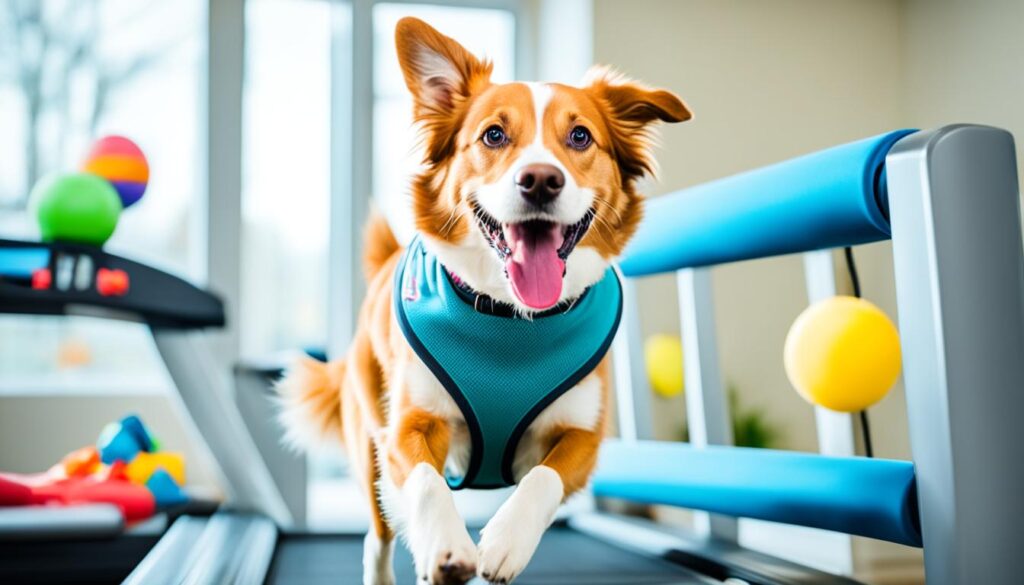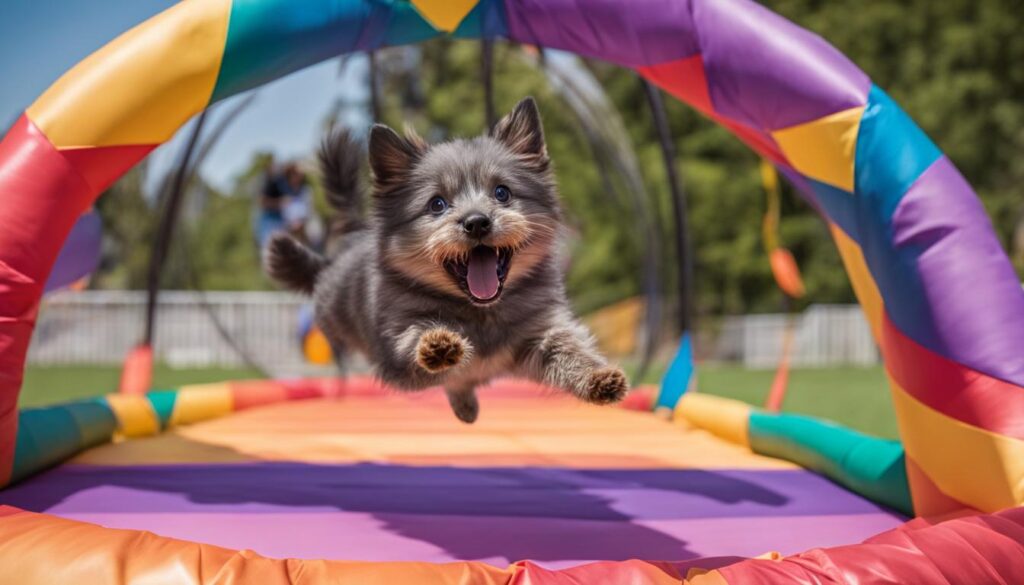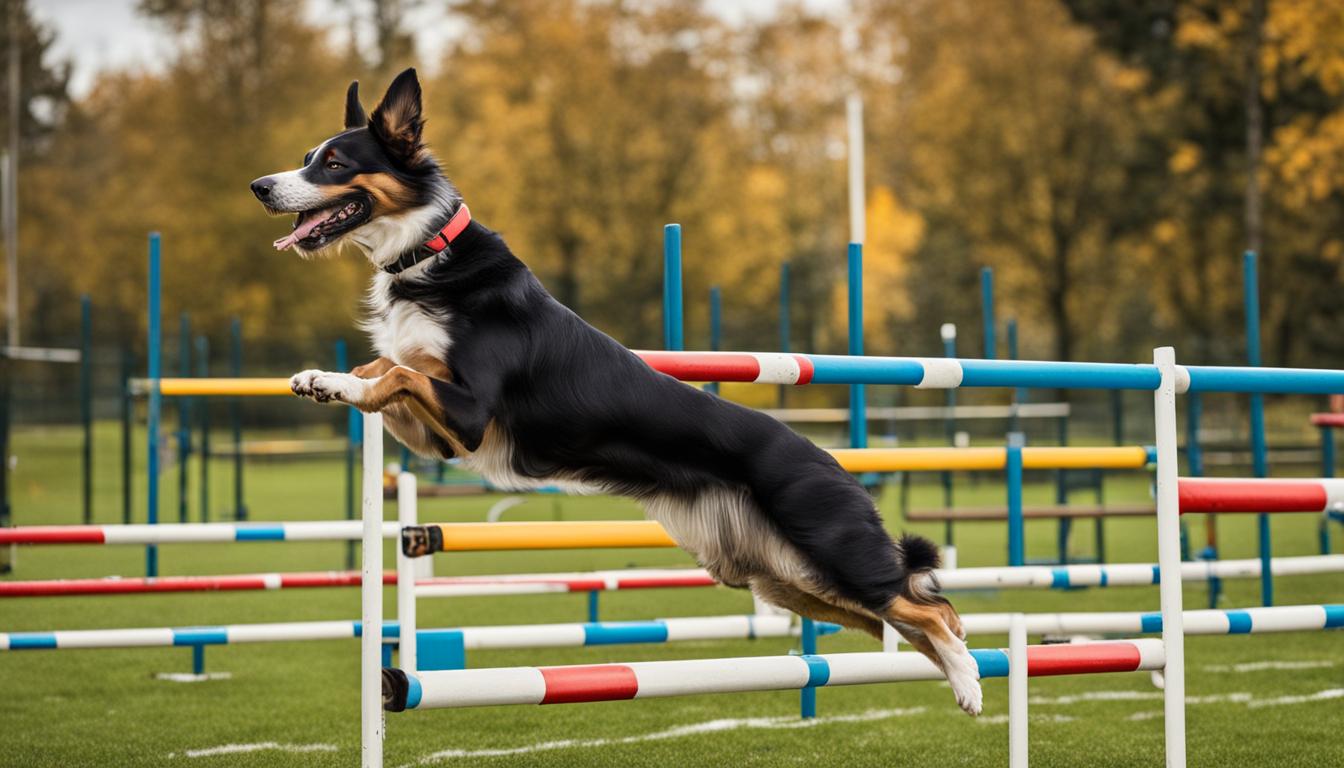Hello, pet owners! As a professional in pet care, I cannot emphasize enough the importance of exercise for your furry companions. Just like humans, pets need regular physical activity to maintain their overall health and well-being. In this article, we will delve into the vital connection between exercise and pet wellness, exploring the physical and mental health benefits it offers. Additionally, I will provide valuable pet health and wellness tips to help you incorporate engaging workouts into your pet’s routine.
Regular exercise plays a crucial role in keeping your pet physically fit. It helps them maintain a healthy weight and muscle tone, improves cardiovascular health, and enhances their overall physical capabilities. Exercise also promotes mental well-being by reducing stress and anxiety, providing mental stimulation, and enhancing their quality of life.
By engaging in active workouts, you can help prevent various health issues in your pet. Exercise aids in preventing obesity, diabetes, heart disease, and joint problems. It is also an integral part of holistic pet health strategies, contributing to their long-term well-being and reducing the need for extensive medical intervention.
In the upcoming sections, we will delve deeper into the impact of exercise on your pet’s well-being and behavioral development. We will discuss age-specific exercise considerations, the importance of customized exercise plans, and the role of exercise in fostering strong bonds between you and your pet.
So, whether you have a playful puppy, a mischievous kitten, or a wise senior pet, stay tuned for informative pet health and wellness tips, engaging workout routines, and expert advice on prioritizing your pet’s physical health.
Key Takeaways:
- Regular exercise is crucial for your pet’s physical and mental well-being.
- Exercise helps maintain a healthy weight, improves cardiovascular health, and enhances overall physical capabilities.
- It reduces stress and anxiety, provides mental stimulation, and enhances their quality of life.
- Engaging in active workouts helps prevent obesity, diabetes, heart disease, and joint problems.
- Exercise fosters strong bonds between you and your pet, promoting a healthier and happier relationship.
Understanding the Impact of Exercise on Your Pet’s Well-being
Evidence suggests that regular exercise plays a vital role in promoting the overall well-being of pets. This section will explore how physical activity affects the well-being of pets, encompassing both their physical and mental health. By understanding the importance of exercise, pet owners can make informed decisions regarding the exercise regimen for their furry companions.
The Vital Connection Between Physical Activity and Pet Wellness
Exercise forms an essential link to the wellness of pets. Engaging in regular physical activity helps pets maintain a healthy weight, build muscle tone, and improve their cardiovascular health. Not only does exercise contribute to their physical well-being, but it also has a profound impact on their mental health. Through exercise, pets receive mental stimulation, reduced stress and anxiety levels, and an overall improvement in mood. By emphasizing the connection between physical activity and pet wellness, pet owners can prioritize exercise in their furry friend’s daily routine.
Physical and Mental Health Benefits of Regular Exercise for Pets
The benefits of regular exercise for pets extend beyond physical fitness. Exercise promotes a range of health benefits, such as improved endurance and flexibility, increased energy levels, and enhanced immune system function. Additionally, it aids in preventing obesity and related health issues, including diabetes and joint problems. Mental health benefits of exercise include decreased boredom, improved cognitive function, and reduced destructive behavior. By incorporating regular exercise into a pet’s daily routine, pet owners can enhance their pet’s physical and mental well-being, ultimately leading to a happier and healthier life.
Optimal Pet Fitness: A Path to Preventive Healthcare
Regular exercise plays a vital role in maintaining the overall health and well-being of pets. It not only helps them stay physically fit but also contributes to their preventative healthcare. Optimal pet fitness is crucial in preventing obesity and related diseases, which can have a significant impact on a pet’s quality of life.
Combating Obesity and Related Diseases with Active Lifestyles
Pet obesity is a growing concern in today’s society, with many pets suffering from weight-related health issues. Regular exercise plays a pivotal role in combating obesity and preventing various associated diseases. By engaging in active lifestyles, pets can burn excess calories, maintain a healthy metabolism, and reduce the risk of conditions such as diabetes, heart disease, and joint problems. Exercise not only helps pets stay physically fit but also boosts their overall well-being.
Exercise as a Pillar of Holistic Pet Health Strategies
Exercise is not just a physical activity; it is a vital pillar of holistic pet health strategies. Alongside proper nutrition and regular veterinary care, exercise plays a significant role in promoting overall well-being and preventing various health issues in pets. It stimulates mental and emotional well-being, reduces stress and anxiety, and improves the bond between pets and their owners. By incorporating exercise into their pet’s routine, owners can contribute to their long-term health and well-being.
Pet Health and Wellness Tips Through Engaging Workouts
When it comes to keeping your pet healthy and happy, incorporating regular exercise into their routine is essential. In this section, we will provide you with valuable pet health and wellness tips through engaging workouts. These exercises will not only keep your pet physically active but also provide mental stimulation and strengthen the bond between you and your furry companion.
One of the simplest and most effective workouts for pets is walking. Taking your pet for daily walks not only provides them with exercise but also allows them to explore and experience the world around them. It’s a great opportunity for both of you to enjoy the fresh air and stay active.
If your pet has more energy to burn, running or jogging can be a fantastic workout option. It helps to improve their cardiovascular health and build endurance. Remember to start slowly, especially for puppies or older pets, and gradually increase the intensity and duration of these workouts.

Interactive playtime is another excellent way to keep your pet active and engaged. Whether it’s playing fetch in the yard or using interactive toys, these activities provide mental stimulation and physical exercise. It’s a win-win situation that keeps them entertained while improving their overall fitness.
If you’re looking for a more advanced workout, agility training can be a fun and challenging activity for your pet. It involves navigating through obstacles, such as tunnels, jumps, and weave poles. Agility training helps improve coordination, speed, and mental focus.
To ensure your pet’s safety during workouts, it’s important to consult with your veterinarian before starting any new exercise routine. They can provide guidance on the appropriate level of physical activity for your pet based on their age, breed, and overall health.
By incorporating these pet health and wellness tips into your pet’s routine, you can ensure they receive the exercise they need to stay physically fit and mentally stimulated. Remember to tailor the workouts to your pet’s abilities and always make it a positive and enjoyable experience for both of you.
How Exercise Contributes to Your Pet’s Behavioral Development
Exercise plays a crucial role in the behavioral development of pets. Insufficient physical activity can contribute to destructive behaviors such as chewing, excessive barking, and digging. Daily exercise helps to channel their energy in a positive way, reducing the likelihood of these behaviors. Additionally, structured activities and training exercises help nurture discipline and obedience in pets, promoting well-behaved and well-adjusted behavior.
Addressing Destructive Behaviors: The Role of Daily Exercise
Regular exercise is key to addressing and preventing destructive behaviors in pets. A tired pet is a well-behaved pet, as exercise helps to release pent-up energy. When pets are physically active, they are less likely to engage in destructive behaviors like chewing on furniture or excessive barking. By providing them with daily exercise, pet owners can create a positive outlet for their energy, keeping them mentally and physically stimulated.
Nurturing Discipline and Obedience with Structured Activities
Structured activities and training exercises contribute to the discipline and obedience of pets. Through consistent training sessions and engaging activities, pets learn to follow commands, understand boundaries, and exhibit desirable behaviors. Training exercises not only teach pets basic obedience but also stimulate their minds and strengthen the bond between pet and owner. By incorporating structured activities into their routine, pet owners can foster a well-behaved and disciplined pet, resulting in a harmonious living environment.
Building Strong Bonds: Exercise as Quality Time with Your Pet
Exercise can be a powerful tool for building strong bonds with pets. Engaging in physical activities together strengthens emotional connections and enhances the bond between pet owners and their furry friends. Playful movements and shared experiences during exercise create joyful moments and deepen the bond between pets and their owners.
Spending quality time with your pet through exercise not only provides physical benefits but also fosters a sense of companionship and mutual trust. The time spent engaging in activities such as playing fetch in the park, going for long walks, or participating in agility training strengthens the emotional connection between you and your pet.
During these moments of shared physical activity, you can observe your pet’s unique personality traits, their enthusiasm, and their eagerness to spend time with you. It allows you to form a deeper understanding of their needs and preferences while creating lasting memories together.
Whether it’s a game of tug-of-war, exploring nature trails, or trying out new tricks, the bond between you and your pet strengthens with every joyful moment experienced during exercise. The combination of physical movement and shared experiences builds a foundation of trust and happiness, enriching both your lives.
Take the opportunity to enjoy quality time with your pet through exercise and witness the remarkable impact it has on your relationship. The emotional connections formed amidst playful movements create a bond that goes beyond words, strengthening the unique connection you share with your beloved pet.

Customized Exercise Plans for Pets: One Size Does Not Fit All
Every pet is unique, and their exercise needs may vary. It’s important to understand that a one-size-fits-all approach to pet exercise is not suitable. To ensure that your furry friend receives the optimal level of physical activity, customized exercise plans tailored to their specific needs are essential.
Consulting Veterinary Experts for Tailored Pet Exercise Programs
When it comes to formulating a personalized exercise plan for your pet, consulting with veterinary experts is highly recommended. Veterinarians possess the knowledge and expertise to assess your pet’s individual requirements and create a tailored exercise program that promotes their overall health and well-being.
During a pet exercise consultation, the veterinarian will consider various factors such as the pet’s breed, age, weight, current physical condition, and any existing health conditions. Based on this evaluation, they will provide specific guidelines and recommendations for a safe and effective exercise routine.
Expert guidance is invaluable in ensuring that your pet engages in appropriate activities that match their unique needs and capabilities. Following a tailored exercise program designed by a veterinary professional can help prevent injuries, minimize the risk of overexertion, and maximize the benefits of physical activity for your furry companion.
Adapting Exercises to Meet the Unique Needs of Different Pets
Exercise plans should not only be customized based on an individual pet’s characteristics, but they should also be adaptable to cater to the diverse needs of different breeds. Various dog breeds, for example, have distinct energy levels, exercise preferences, and physical limitations.
By considering the unique traits of your pet’s breed, you can adjust their exercise routine accordingly. Some breeds may require more intense workouts and activities to satisfy their energy levels, while others may benefit from low-impact exercises or shorter sessions due to their physical limitations.
It’s essential to pay attention to your pet’s cues and adjust the intensity, duration, and type of exercise to ensure their comfort and safety. For example, brachycephalic breeds like Bulldogs or Pugs may struggle with excessive heat or strenuous activities due to their compromised respiratory systems. In contrast, high-energy breeds like Border Collies may thrive with agility training or mental stimulation exercises.
By tailoring exercises to meet the unique needs of different pets, you can ensure that they receive the appropriate level of physical activity to maintain their overall health and well-being.
Pet Exercise Guidelines: Customized for Optimal Health
| Breed | Exercise Recommendations |
|---|---|
| Small and Toy Breeds (e.g., Chihuahua, Maltese, Yorkshire Terrier) | Gentle walks, indoor play, interactive toys |
| Medium and Large Breeds (e.g., Golden Retriever, Labrador Retriever, German Shepherd) | Regular walks, jogs, fetch, swimming |
| Giant Breeds (e.g., Great Dane, Saint Bernard, Mastiff) | Controlled walks, low-impact exercises, mental stimulation |
| Working Breeds (e.g., Border Collie, Australian Shepherd, Siberian Husky) | Agility training, advanced obedience exercises, high-intensity play |
These guidelines provide a general framework for tailoring exercise plans based on different breeds. However, it’s important to remember that individual variations exist within each breed, so always consult with a veterinary professional for personalized recommendations.
By embracing customized exercise plans and seeking pet exercise consultation, you can ensure that your furry friend enjoys a physically enriching lifestyle that fosters optimal health and well-being.
Age-Specific Exercise Considerations for Pets
Exercise is an important aspect of pet care, and the needs for exercise can vary depending on a pet’s age. Puppies and kittens have different exercise requirements compared to adult or senior pets. By understanding age-specific exercise considerations, pet owners can ensure that their furry friends receive the appropriate physical activity to promote their overall health and well-being.
Dynamic Exercise Routines for Puppies and Kittens
When it comes to young pets, such as puppies and kittens, dynamic exercise routines are essential for their growth and development. These exercises should be tailored to their age and physical abilities to prevent any strain or injury. Encouraging activities that involve controlled movements, such as gentle play sessions, short walks, and interactive toys, can help young pets build strength, coordination, and social skills.

Special Attention to Senior Pet Mobility and Stamina
As pets age, their mobility and stamina may decline. It’s important to provide exercise opportunities that are appropriate for senior pets to keep them active and healthy. Low-impact exercises, such as gentle walks, swimming, and stretching exercises, can help maintain muscle tone, joint flexibility, and cardiovascular health. It’s crucial to consider their individual needs, health conditions, and any mobility issues when designing exercise routines for older pets.
Exercise Guidelines for Pets of Different Ages
| Pet Age | Recommended Exercise Activities |
|---|---|
| Puppies and Kittens | Gentle play sessions, short walks, interactive toys |
| Adult Pets | Moderate to high-intensity activities, such as running, hiking, and agility training |
| Senior Pets | Low-impact exercises, gentle walks, swimming, stretching exercises |
By adapting exercise routines to meet the specific needs of puppies, kittens, adult pets, and senior pets, pet owners can ensure that their beloved companions maintain optimal physical health, regardless of age.
Introducing Diverse and Enjoyable Workouts for Your Pet
Keeping pets active and engaged requires diverse and enjoyable workouts. In this section, we will introduce a variety of creative ways to exercise pets, from traditional games like fetch to more advanced activities like agility training. Additionally, we will explore innovative exercise alternatives such as interactive games and puzzles that provide mental stimulation alongside physical activity, ensuring that pets remain entertained and active.
From Fetch to Agility: Creative Ways to Keep Your Pet Active
Playing fetch is a classic and simple way to keep your pet physically active and mentally stimulated. You can use a tennis ball, a frisbee, or even a favorite toy to engage your pet in this exciting game. Throw the object a short distance at first, gradually increasing the distance as your pet becomes more comfortable fetching.
Another fantastic option for keeping your pet active is agility training. Set up a small obstacle course in your backyard or a nearby park using items like cones, tunnels, and jumps. Guide your pet through the course, encouraging them with treats and praise. Not only will this help them burn off excess energy, but it will also improve their coordination and problem-solving skills.

Innovative Exercise Alternatives: Leveraging Games and Puzzles
For a mental workout that keeps your pet entertained, consider interactive games and puzzles. There are a wide variety of puzzle toys available that require your pet to solve a problem or manipulate objects to access treats or toys. These puzzles stimulate their cognitive abilities while providing a fun and rewarding challenge.
You can also create DIY games at home by hiding treats or toys around your living space and encouraging your pet to search for them. This engages their senses and natural curiosity, keeping them mentally engaged and physically active.
By incorporating these diverse and enjoyable workouts into your pet’s routine, you can ensure they remain engaged, active, and happy. From fetch games to agility training, and from interactive puzzles to DIY games, the options are endless when it comes to keeping your pet entertained and exercised.
Conclusion
In conclusion, regular exercise plays a vital role in achieving a harmonious blend of happy pets and healthy lifestyles. Prioritizing your pet’s physical health through engaging workouts not only improves their overall well-being but also reduces the risk of health issues in the long run. By incorporating exercise into your pet’s routine, you can enhance their mental health and strengthen the bond between you and your furry companion.
Exercise offers lifelong benefits for your pet’s physical and mental health. It promotes muscle tone, cardiovascular health, and weight management, ensuring that your pet stays fit and energetic. Additionally, a consistent exercise routine helps to reduce stress and anxiety in pets, contributing to their mental well-being and overall happiness.
Remember, making exercise a priority in your pet’s care is essential. By setting aside time and incorporating diverse and enjoyable workouts into their daily routine, you are investing in their long-term health and happiness. So, lace up your shoes, grab a leash or a toy, and embark on the journey of exploring engaging workouts that will keep your pet active, healthy, and thriving!
FAQ
What role does exercise play in my pet’s physical health?
Regular exercise is vital for maintaining your pet’s physical health. It helps them stay fit, maintain a healthy weight, and improves cardiovascular health. Exercise also promotes mental well-being, reduces stress and anxiety, and enhances overall quality of life for your pet.
How does exercise contribute to my pet’s well-being?
Exercise has a significant impact on your pet’s physical and mental health. It keeps them fit, helps prevent obesity and related diseases, and promotes holistic pet health. Exercise also stimulates mental stimulation, reduces destructive behaviors, and nurtures discipline and obedience in pets.
What are some pet health and wellness tips through engaging workouts?
Here are some tips for keeping your pet healthy and well through exercise. You can incorporate activities like walking, running, interactive play, and agility training into their routine. These workouts not only keep your pet physically active but provide mental stimulation and strengthen the bond between you and your furry companion.
How does exercise contribute to my pet’s behavioral development?
Insufficient physical activity can contribute to destructive behaviors in pets. Daily exercise helps channel their energy in a positive way, reducing the likelihood of behaviors like chewing, excessive barking, and digging. Structured activities and training exercises also nurture discipline and obedience in pets, promoting well-behaved and well-adjusted behavior.
Can exercise strengthen the bond between me and my pet?
Absolutely! Engaging in physical activities with your pet strengthens the bond and emotional connection between you. Playful movements and shared experiences during exercise create joyful moments that deepen the bond between you and your pet, enhancing the overall relationship.
Should exercise be customized for each individual pet?
Yes, each pet has unique exercise needs. It’s important to consult veterinary experts who can provide valuable insights and tailored exercise programs based on your pet’s specific needs. Different breeds may also require different levels and types of exercise to ensure their overall health and well-being.
How does exercise differ for puppies, kittens, and senior pets?
Exercise needs vary depending on your pet’s age. Puppies and kittens have different exercise needs compared to adult or senior pets. In their early stages of development, dynamic exercise routines promote growth and development. Senior pets require special attention to mobility and stamina, ensuring they receive appropriate exercises to keep them active and healthy.
What are some diverse and enjoyable workouts for my pet?
Keeping your pet active and engaged requires diverse workouts. You can engage them in traditional games like fetch and more advanced activities like agility training. Additionally, innovative exercise alternatives such as interactive games and puzzles provide mental stimulation alongside physical activity, ensuring your pet remains entertained and active.
Source Links
- https://chhs.source.colostate.edu/exercise-good-for-you-and-your-pet/
- https://www.mainstreetvets.co/blog/the-importance-of-exercise-for-your-pets-physical-and-mental-health/
- https://fitzroyvet.com.au/pet-advice/the-benefits-of-exercise-for-your-pet/

